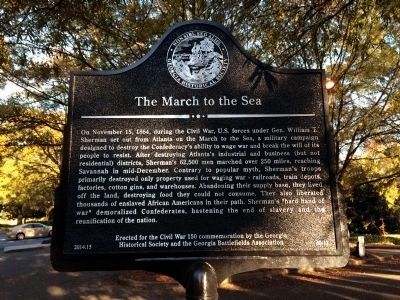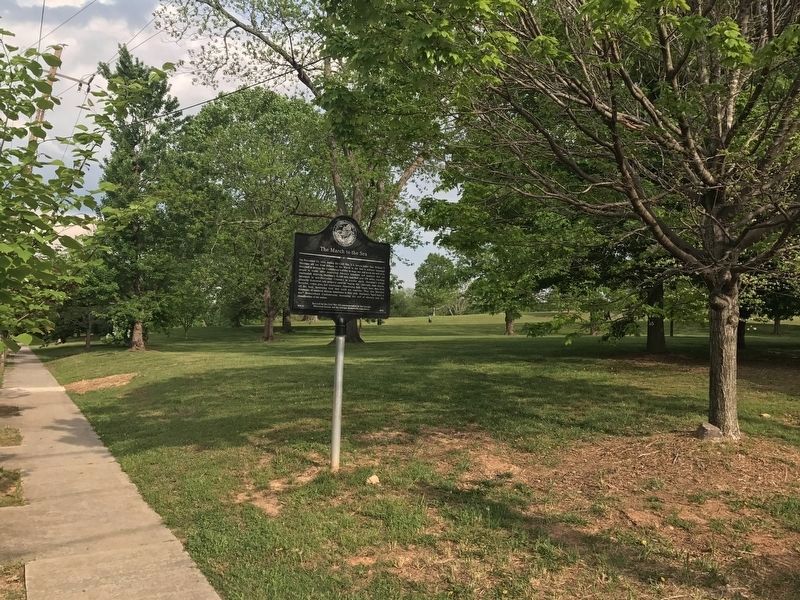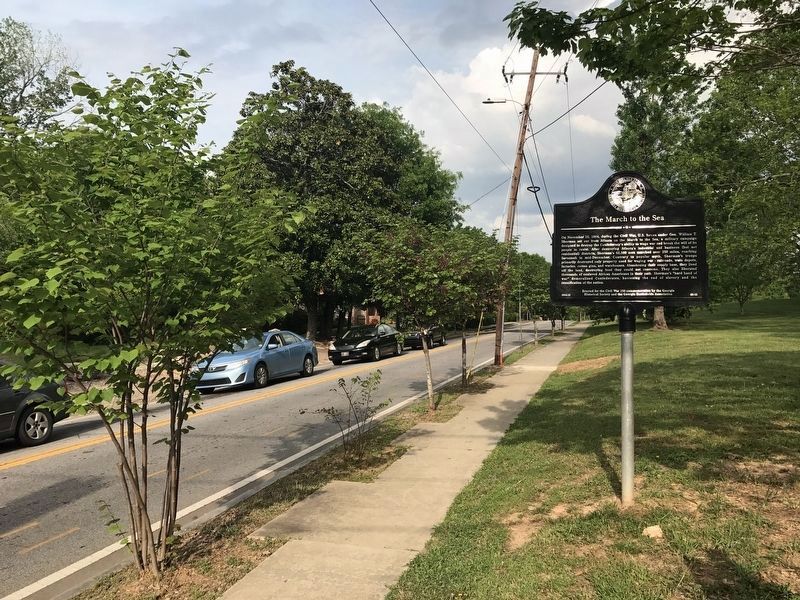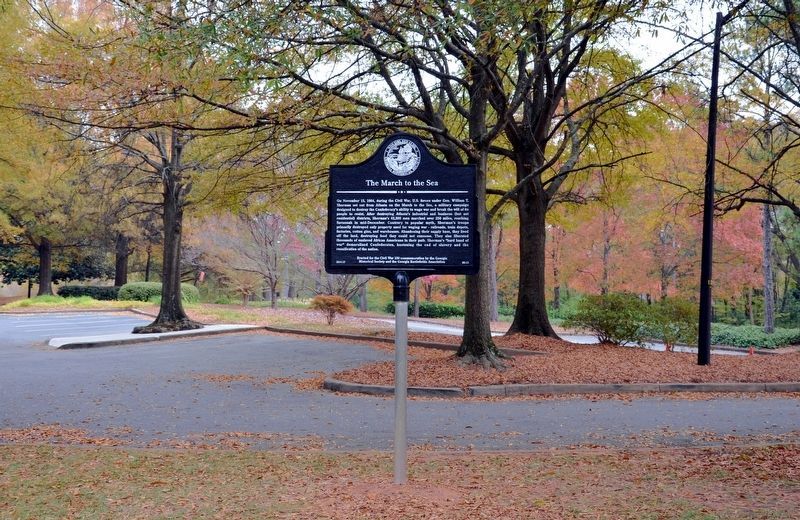Candler Park in Atlanta in DeKalb County, Georgia — The American South (South Atlantic)
The March to the Sea
On November 15, 1864, during the Civil War, U.S. forces under Gen. William T. Sherman set out from Atlanta on the March to the Sea, a military campaign designed to destroy the Confederacy's ability to wage war and break the will of its people to resist. After destroying Atlanta's industrial and business (but not residential) districts, Sherman's 62,500 men marched over 250 miles, reaching Savannah in mid-December. Contrary to popular myth, Sherman's troops primarily destroyed only property used for waging war - railroads, train depots, factories, cotton gins, and warehouses. Abandoning their supply base, they lived off the land, destroying food they could not consume. They also liberated thousands of enslaved African Americans in their path. Sherman's "hard hand of war" demoralized Confederates, hastening the end of slavery and the reunification of the nation.
Erected for the Civil War 150 commemoration by the Georgia Historical Society and the Georgia Battlefields Association
Erected 2014 by Georgia Historical Society and Georgia Battlefields Association. (Marker Number 60-13.)
Topics and series. This historical marker is listed in these topic lists: African Americans • War, US Civil . In addition, it is included in the Georgia Historical Society, and the Sherman’s March to the Sea series lists. A significant historical month for this entry is November 1850.
Location. 33° 46.238′ N, 84° 20.926′ W. Marker is in Atlanta, Georgia, in DeKalb County. It is in Candler Park. Marker is at the intersection of Moreland Avenue NE (U.S. 23) and North Avenue NE, on the right when traveling north on Moreland Avenue NE. Located in Freedom Park. Touch for map. Marker is at or near this postal address: 602 Moreland Ave NE, Atlanta GA 30307, United States of America. Touch for directions.
Other nearby markers. At least 8 other markers are within walking distance of this marker. Old Williams Mill Rd. (approx. 0.3 miles away); The Battles for Atlanta (approx. half a mile away); Stanley's Sector (approx. half a mile away); Augustus Hurt Plantation (approx. half a mile away); Lynching in America / The Lynching of Porter Turner (approx. half a mile away); Augustus Hurt House (approx. half a mile away); Alpha Delta Pi (approx. half a mile away); Sightless Among Miracles (approx. half a mile away). Touch for a list and map of all markers in Atlanta.
More about this marker. This marker was moved in 2015 from 33° 46.017′ N, 84° 21.317′ W, at the parking lot of the Jimmy Carter Presidential Library and Museum near
the location of the Augustus Hurt plantation (441 Freedom Pkwy NE near Albion Avenue, Atlanta GA 30307). This former location was in Fulton County.
Additional commentary.
1. Atlanta Residences Burned by Sherman
There are many historians who dispute a number of the statements on the marker and use of the word "myth." Sherman's army not only burned a number of residences in Atlanta but all outbuildings -- barns, smokehouses and similar structures as well as plantation houses on The March to the Sea.
Franklin Garrett's three-volume Atlanta and its Environs on pages 655-658 of Volume I includes a list of a number of specific residences burned, naming the owner and location. He also quotes General W.P. Howard's report to Governor Joseph E. Brown. One statement from the report: "By the failure of the fire fiends to perform the task assigned to them of destroying private dwellings, nearly one out of three escaped, while the whole of the real estate of the city fully five-sixths in values have been laid in ashes."
Franklin Garrett (1906-2000) was the official Atlanta City Historian.
— Submitted October 17, 2017, by David Seibert of Sandy Springs, Georgia.
Credits. This page was last revised on February 8, 2023. It was originally submitted on November 11, 2014, by Christian Belena of Atlanta, Georgia. This page has been viewed 1,160 times since then and 68 times this year. Last updated on April 19, 2017, by Jay Sandhaus of Atlanta, Georgia. Photos: 1. submitted on November 11, 2014, by Christian Belena of Atlanta, Georgia. 2, 3. submitted on April 19, 2017, by Jay Sandhaus of Atlanta, Georgia. 4. submitted on October 17, 2017, by David Seibert of Sandy Springs, Georgia. • Bernard Fisher was the editor who published this page.



